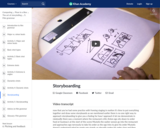
Storyboarding your scene.
- Subject:
- Applied Science
- Arts and Humanities
- Computer Science
- Graphic Arts
- Material Type:
- Lesson
- Provider:
- Khan Academy
- Provider Set:
- Pixar
- Author:
- Disney Pixar
- Khan Academy
- Date Added:
- 07/14/2021

Storyboarding your scene.
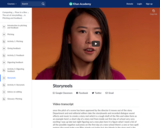
Introduction to storyreels.
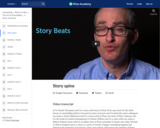
Introduction to story beats and the story spine.
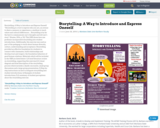
Storytelling: A Way to Introduce and Express Oneself
“Storytelling is a tool to express who you are, an avenue to share a memory or experience, a medium to teach values and cultural differences….Storytelling is by far the best to communicate one’s thoughts and tell one’s story” (Keaise, 2014, p. 53).
This OER shows how one professor incorporated storytelling into student introductions. Additionally, this exercise was used as part of the pedagogy to teach about human diversity, culture, understanding and acceptance. Storytelling provided an effective foundation for students to connect with classmates, build relationships and develop trust and respect, the foundation behaviors of good human relations.
Materials which will be included in the OER are listed below:
1) A brief literature review on storytelling, supporting this exercise;2) A visual diagram and brief description of the storytelling process which includes a dyadic encounter, small group discussions and a large group presentation; 3) Step-by-step instructions on how to integrate storytelling into student introductions; 4) Examples of student introductions; 5) A summary of student perceptions about the storytelling exercise.
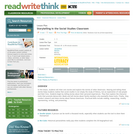
People make the past come alive as students research and then share stories about famous Americans who promoted democratic ideals.
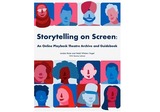
Playback Theatre is a form of community-centered storytelling theater where the audience tells stories, which are then reflected by a company of actors and musicians. Storytelling on Screen: An Online Playback Theatre Archive and Guidebook is an open education resource consisting of a collection of full-length recordings of online Playback Theatre performances, and a 55-page explanatory guidebook. The guidebook, featuring a foreword by Playback Theatre co-founder, Jo Salas, explains the adaptation to online performances and some of the key concepts, roles, and forms involved in online Playback Theatre. The resource as a whole is suitable for a wide range of theatre students in courses such as applied theatre, theatre for social justice, improvisation, theatre appreciation, or acting. The guidebook contains hyperlinks to specific sections of the archive where students can see a given form or concept in action, allowing for a comparison of how different companies approach a given form.
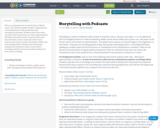
This is an assignment for an Introduction to Media course. The activity includes students comparing and contrasting historic radio productions and contemporary podcasts. Students then choose their own short story, essay, poem, etc. that is approximately 200-300 words and/or under 5 minutes when read aloud. Students create a transcript of their story selection and create an audio recording on Padlet.com, a free media platform. Students then share their readings with classmates, listen to each other's recordings and discuss several creative attributes of their audio recordings.
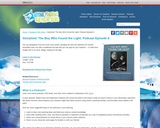
In this podcast, listen to a traditional Inuit tale about the seasonal light and darkness of the Arctic.

Unlike film, theater in America does not have a ratings board that censors content. So plays have had more freedom to explore and to transgress normative culture. Yet censorship of the theater has been part of American culture from the beginning, and continues today. How and why does this happen, and who decides whether a play is too dangerous to see or to teach? Are plays dangerous? Sinful? Even demonic? In our seminar, we will study plays that have been censored, either legally or extra-legally (i.e. refused production, closed down during production, denied funding, or taken off school reading lists). We’ll look at laws, both national and local, relating to the “obscene”, as well as unofficial practices, and think about the way censorship operates in American life now. And of course we will study the offending texts, themselves, to find what is really dangerous about them, for ourselves.
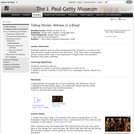
Students explore how an artist emphasized the narrative in a work of art that depicts a single moment from the story. They then write a newspaper article, using visual clues in the painting to imagine how the narrative depicted may have unfolded.
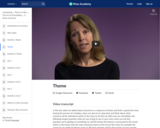
Theme and structure.

This lesson provides teachers with support for using text-dependent questions and Common Core literacy strategies to help students derive big ideas and key understandings while developing vocabulary using the text "Tomas and the Library Lady". With the help of the English-speaking local librarian, Spanish-speaking Tomas is encouraged to assume the role of family storyteller, finding that he cannot only be a learner but a teacher as well.
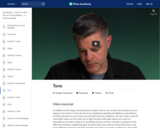
The use of tone in visual storytelling.
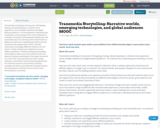
Transmedia storytelling is the practice of designing, sharing, and participating in a cohesive story experience across multiple traditional and digital delivery platforms - for entertainment, advertising and marketing, or social change.
This course will help you to design a strategy for developing and telling your own transmedia story. You will learn about what it takes to:
• Shape your ideas into compelling and well structured narratives and complex story worlds
• Identify, understand, and engage different audiences in your stories
• Create cohesive user experiences across different platforms
• Evaluate existing and emerging technologies to share your story with the world, and help your audience participate in the larger storyworld you create
The course provides you with a unique, authentic, and industry relevant learning opportunity. You will have access to current theory, industry examples and advice and undertake learning activities that will equip you with the tools you need to start developing your own ideas.

The subtitle of this course for the spring 2003 term is “American Television: A Cultural History.” The class takes a cultural approach to television’s evolution as a technology and system of representation, considering television as a system of storytelling and myth-making, and as a cultural practice, studied from anthropological, literary, and cinematic perspectives. The course focuses on prime-time commercial broadcasting, the medium’s technological and economic history, and theoretical perspectives. There is much required viewing as well as readings in media theory and cultural interpretation.

The Visual Storytelling lesson plan is a series of four learning ladder activities designed around mobile/digital technology for use by intermediate art and design students. It is a framework for concept ideation, visual design planning, and production. Activity 1: Story Slides is a foundational activity for developing narrative visual storytelling skills. It can be used as an icebreaker for introductions as well as provide the instructor with an authentic assessment of current student visual design skills.

The Visual Storytelling lesson plan is a series of four learning ladder activities designed around mobile/digital technology for use by intermediate art and design students. It is a framework for concept ideation, visual design planning, and production. Activity 2: Concept Mapping is a foundational activity for developing narrative visual storytelling skills. Mapping is utilized to exampine concepts for story development and visual design.

The Visual Storytelling lesson plan is a series of four learning ladder activities designed around mobile/digital technology for use by intermediate art and design students. It is a framework for concept ideation, visual design planning, and production. Activity 3: Subtext Storyboard is a versitle tool students can use to develop including both abstract concepts and narrative structure.

The Visual Storytelling lesson plan is a series of four learning ladder activities designed around mobile/digital technology for use by intermediate art and design students. It is a framework for concept ideation, visual design planning, and production. Activity 4: Design Matrix introduces students to production planning for multiple types of media.

This course is an introduction to principles and techniques of visual communication, and provides opportunities for science and engineering majors to acquire practical skills in the visual computer arts, in a studio environment. Students will learn how to create graphics for print and web, animations, and interactive media, and how to use these techniques to effectively communicate scientific and engineering concepts for learning and teaching. This class involves three hands-on creative projects, which will be presented in class.